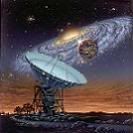Post by glactus on Feb 18, 2008 7:53:45 GMT

Listening to Andromeda - A James Dyson image
Incredibly, it's been only a bit more than a century since Oliver Heaviside consolidated the work of several 19th century physicists into the four compact mathematical formulations known as Maxwell's Equations.
We have exploited Maxwell's Equations like an old-growth forest, and we know all there is to know about them.
And the fact that it's untrue may affect our thinking about SETI.
Today's SETI experiments generally look for what are politely termed "narrow-band signals - a signal that's very constrained in frequency. By putting all the transmitted power into this small bandwidth, the aliens can ensure that their signal will stand out like Yao Ming at a Munchkin picnic.
That makes sense, at least if the aliens want only to help us find their signal. But they might have other priorities. In particular, the history of earthly communication suggests that there is an inexorable pressure to increase the bit rate of any transmission channel.
Back and forth conversations will take too long. So perhaps the aliens will opt to send, not the easiest-to-find signal, but a signal that says it all, a signal bristling with information. If you're going to stuff a message into a bottle, why not use onion-skin paper and write small.
A narrow-band signal (the acoustical analog is a simple flute note) would not be adversely affected.
So it may be that our search for narrow-band signals is actually a very good SETI strategy, and not just an obvious one. While such monotonic messages may seem to be elementary and devoid of much information, they could be laden with additional, hidden complexity.
The investigation of new transmission modes by Thide and Bergman hints that if we do find a signal from ET, we may wish to reconfigure our radio telescopes to look for encoding of the message via such subtle effects as orbital angular momentum.
A simple signal may only be a cipher for a more complex message, and there may be more things in heaven and earth than even Maxwell had dreamt of.

Is anyone there?
credits:
Original source -The Seti Institute - article credit: Seth Shostak
This is part text only. See full text and all scientists involved at space.com - Galactic WiFi
www.space.com/searchforlife/080131-seti-galactic-wifi.html
Image credit: Andromeda Galaxy image by James Dyson 2007
Insert image credit: The SETI Institute.
image insert by Glactus


